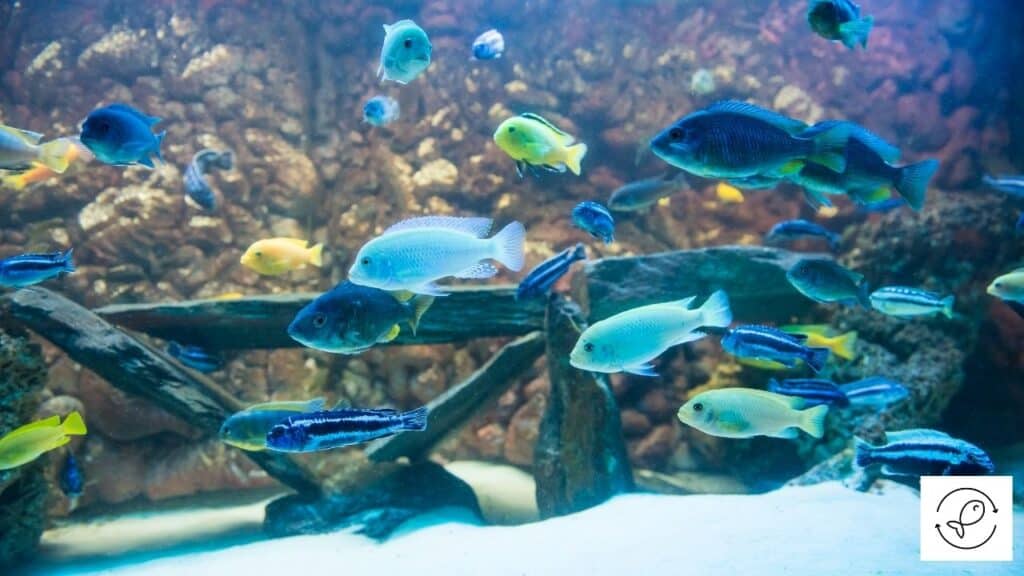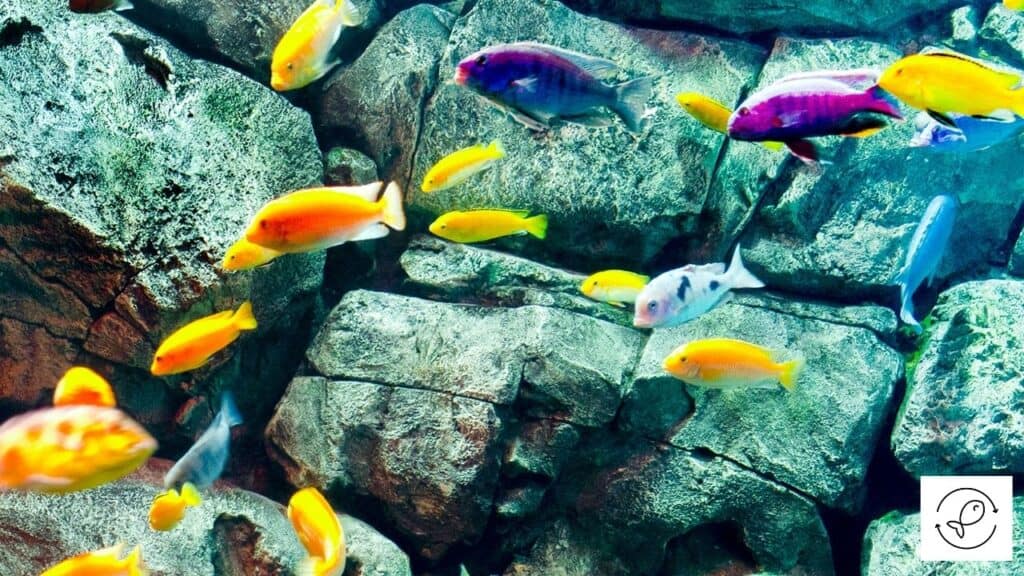Cichlids shake their body in aggression to warn potential intruders as they are territorial. Cichlids also shake their bodies or tremble due to an illness, parasitic infection, or when exposed to cold water temperatures. Moreover, male cichlids shake their bodies to dance and woo potential mates.
Let’s now understand the various other reasons why cichlids shake.
4 Reasons Why Cichlids Shake
Cichlids shake their bodies to communicate or warn the other fish inside an aquarium.
However, these subtle differences in body movements can be difficult for aquarium owners to understand.
Given below are the four main reasons why cichlids shake their bodies.
1. Display Aggression & Dominance
Male cichlids want to dominate the fish tank.
So if you see two males shaking, vibrating, and circling each other, it means face-off will ensue for deciding the pecking order.
Such battles are regular and can be brutal as well.
These fights lead to establishing hierarchy and territories inside the aquarium.
The victorious male controls the territory and the food, while the loser lives an everyday life and stays away from the dominant male.
However, this is a continuous process.
This means such confrontations happen when the new young males challenge the hierarchy.
Sometimes, these battles can also happen after a significant water change that removes the dominant male from the tank during the water change.
If the hierarchy changes, the new dominant male fish will now enjoy the top position in the social hierarchy.
In addition, he will also establish his territory and control inside the tank.
2. Woo Female for Mating
Male cichlids will shake or shimmer their bodies to flirt with the female cichlids.
Males also show off their vibrant colors to attract females.
They may even chase their potential mate or bite her fins to seek attention.
Finally, male cichlids dig a nest for the female and lure her by doing a fin-shaking dance.
Once a male woos the female cichlid, the male will take the consenting female to the nesting place.
The female will lay her eggs in the nest, and the male will fertilize them.
So if you notice a male shaking himself and making eccentric moves in front of the female, expect a batch of tiny cichlids in a couple of weeks.
3. Illness or Infections
Another reason your cichlid is shaking, vibrating, or looking dull might be due to an illness, injury, or infection that has made it weak and delicate.
Cichlids are susceptible to parasitic infections.
Common indications of parasites in cichlids include swelling, loss of appetite, and lack of energy.
If a cichlid has parasitic infections, you will likely be able to see them.
In case of fungal infections, you will see lumps on the fish’s body.
On the other hand, bacterial infections will affect breathing. As a result, your cichlid will exhibit signs of breathing issues.
If you notice that your cichlid is behaving unusually and you aren’t sure about the cause, it’s always best to consult a veterinarian.
4. Cold Water Temperatures
Cichlids are freshwater fish that inhabit tropical waters.
So they are used to warm waters and need water temperature in the range of 75°F to 85°F (24°C to 29.5°C).
Although cichlids are hardies, they will shake or tremble if exposed to cold water temperatures.
So you must maintain the temperature range to avoid high variations.
Cichlids also prefer stable water parameters.
So the tank needs a proper filtration system and periodic water change to maintain high oxygen levels.
If there’s a spike in the ammonia level of the tank, it will make your fish sick, and it will start showing signs like shaking, twitching, and panting.
This means it’s time to move your fish to a quarantine tank for treatment.
Now that you know why cichlids shake their bodies, let’s understand what you should do if your cichlid is shaking.
What Should You Do If Your Cichlid Is Shaking?

As an aquarium owner, you must understand the reason for your cichlid’s shaky movements.
Without understanding the cause, you will be unable to take proper action.
Given below are some ways you can de-stress your cichlid to stop its shaking.
1. Create Partition or Hiding Places
Cichlids are aggressive fish and can get into a face-off.
So it would help if you were watchful because any unnecessary aggression from the dominant male cichlid can injure the other fish.
You can either move the aggressor cichlid to another tank or add a tank partition to establish territories and help the other cichlids stay away from the dominant male cichlid.
You can also create hiding places by using live plants, rocks, and caves to allow the submissive cichlid to seek refuge and avoid confrontation.
2. Increase Female Cichlids
If the male cichlid is shaking or vibrating to mate, you can ignore his movements.
However, if you see a female cichlid stressed out due to the constant nipping and attention, it’s best to add more females in the tank to divide the attention and aggression of the male cichlid.
3. Check Water Parameters
Cichlids need stable water parameters. An increase in ammonia level will make cichlids sick.
So you must install a sound filtration system to reduce ammonia.
You can also perform regular water changes to maintain water quality and high oxygenation levels in the tank.
4. Maintain Water Temperatures
Cichlids need water temperature in the range of 75°F to 85°F (24°C to 29.5°C).
They feel stressed when exposed to cold waters.
So it’s essential to maintain water temperature within the desired range.
Installing a heater is the best way to avoid temperature variation due to a drop in the ambient temperature.
Why Do Cichlids Shake Their Head?
Cichlids usually shake their head when ammonia levels in the tank water increase. Poor water quality is the most common reason cichlids twitch or shake their heads.
If the pH level of water drops below 5.6, then a cichlid can start getting a burning sensation on its skin.
If you see your cichlid frequently twitching or shaking its head, immediately check the water quality.
However, it’s pretty standard for cichlids to shake their head for a short time.
So it’s best to ignore if you observe your cichlid shaking its head for a few minutes.
But if your cichlid shakes its head rapidly and uncontrollably for more than five minutes, immediately check the water parameters as a precautionary measure.
In case of a problem with the water quality, you must move the sick cichlid to a quarantine tank for treatment.
You can also perform a water change to restore the aquarium’s water quality.
Why Do African Cichlids Shake?
Most African cichlids shake their bodies to display dominance or threaten possible intruders in their territory. But they can also shake or vibrate their body to flirt or woo a female cichlid. Moreover, African cichlids shake their bodies when stressed due to incorrect water parameters.
African cichlids are the most diverse group of the cichlid family.
They are also one of the largest freshwater aquarium fish that grow between four to ten inches in length.
They are very colorful, vibrant, and very hardy. These cichlids are also easy to care for and maintain.

